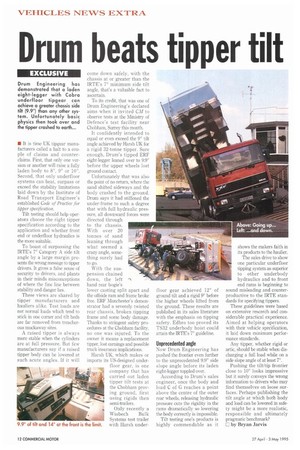Drum beats tipper tilt
Page 14

If you've noticed an error in this article please click here to report it so we can fix it.
MI It is time UK tipgear manufacturers called a halt to a couple of claims and counterclaims. First, that only one version or another will raise a fully laden body to 8', 9° or 10°. Second, that only underfloor systems can beat, surpass or exceed the stability limitations laid down by the Institute of Road Transport Engineer's established Code of Practice for tipper specification.
Tilt testing should help operators choose the right tipper specification according to the application and whether front end or underfloor hydraulics is the more suitable.
To boast of surpassing the IRTE's 7° Category A side tilt angle by a large margin presents the wrong message to tipper drivers. It gives a false sense of security to drivers, and plants in their minds misconceptions of where the fine line between stability and danger lies.
These views are shared by tipper manufacturers and hauliers alike. Test loads are not normal loads which tend to stick in one corner and tilt beds are far removed from treacherous muckaway sites.
A raised tipper is always more stable when the cylinders are at full pressure. But few manufacturers say if a raised tipper body can be lowered at such acute angles. If it will
come down safely, with the chassis at or greater than the IRTE's 70 minimum side tilt angle, that's a valuable fact to ascertain.
To its credit, that was one of Drum Engineering's declared aims when it invited CM to observe tests at the Ministry of Defence's test facility near Chobham, Surrey this month.
It confidently intended to equal or even exceed the 90 tilt angle achieved by Harsh La for a rigid 32-tonne tipper. Sure enough, Drum's tipped ERF eight-legger leaned over to 9.90 before the upper wheels lost ground contact.
Unfortunately that was also the point of no return, where the sand shifted sideways and the body crashed to the ground. Drum says it had stiffened the under-frame to such a degree that with full hydraulic pressure, all downward forces were directed through to the chassis. With over 20 tonnes of sand leaning through what seemed a crazy angle, something surety had to go.
With the suspension chained down, the left hand rear bogie's lower casting split apart and the offside ram and frame broke free. ERF Manchester's demonstrator had a severely twisted rear chassis, broken tipping frame and some body damage. Thanks to stringent safety procedures at the Chobham facility, no one was injured. To the owner it means a replacement tipper, lost earnings and possible truck insurance implications.
Harsh UK, which makes or imports its US-designed underfloor gear, is one company that has carried out laden tipper tilt tests at the Chobham proving ground, first using rigids then semi-trailers.
Only recently a Wisbech Bulk Systems test trailer
floor gear achieved 120 of ground tilt and a rigid 90 before the higher wheels lifted from the ground. These results are published in its sales literature with the emphasis on tipping safety. Edbro too proved its TS32 underbody hoist could attain the IRTE's 70 guideline.
Unprecedented angle
Now Drum Engineering has pushed the frontier even further to the unprecedented 9.9° side slope angle before its laden eight-legger toppled over.
According to Drum's sales engineer, once the body and load C of G reaches a point above the centre of the outer rear wheels, releasing hydraulic pressure cuts the rigidity in the rams dramatically so lowering the body correctly is impossible.
Tilt testing one's products is highly commendable as it shows the makers faith in its products to the haulier.
The sales drive to show one particular underfloor tipping system as superior to other underbody hydraulics and to front end rams is beginning to sound misleading and counter. productive to the IRTE stan. dards for specifying tippers.
These guidelines were based on extensive research and considerable practical experience. Aimed at helping operators with their vehicle specification, it laid down minimum performance standards.
Any tipper, whether rigid or artic, should be stable when discharging a full load while on a side slope angle of at least 7'.
Pushing the tilt/tip frontier close to 100 looks impressive but it surely conveys the wrong information to drivers who may find themselves on loose surfaces. Perhaps publishing the tilt angle at which both body and load can be lowered in safety might be a more realistic, responsible and ultimately pragmatic benchmark?
C by Bryan Jarvis




























































































































